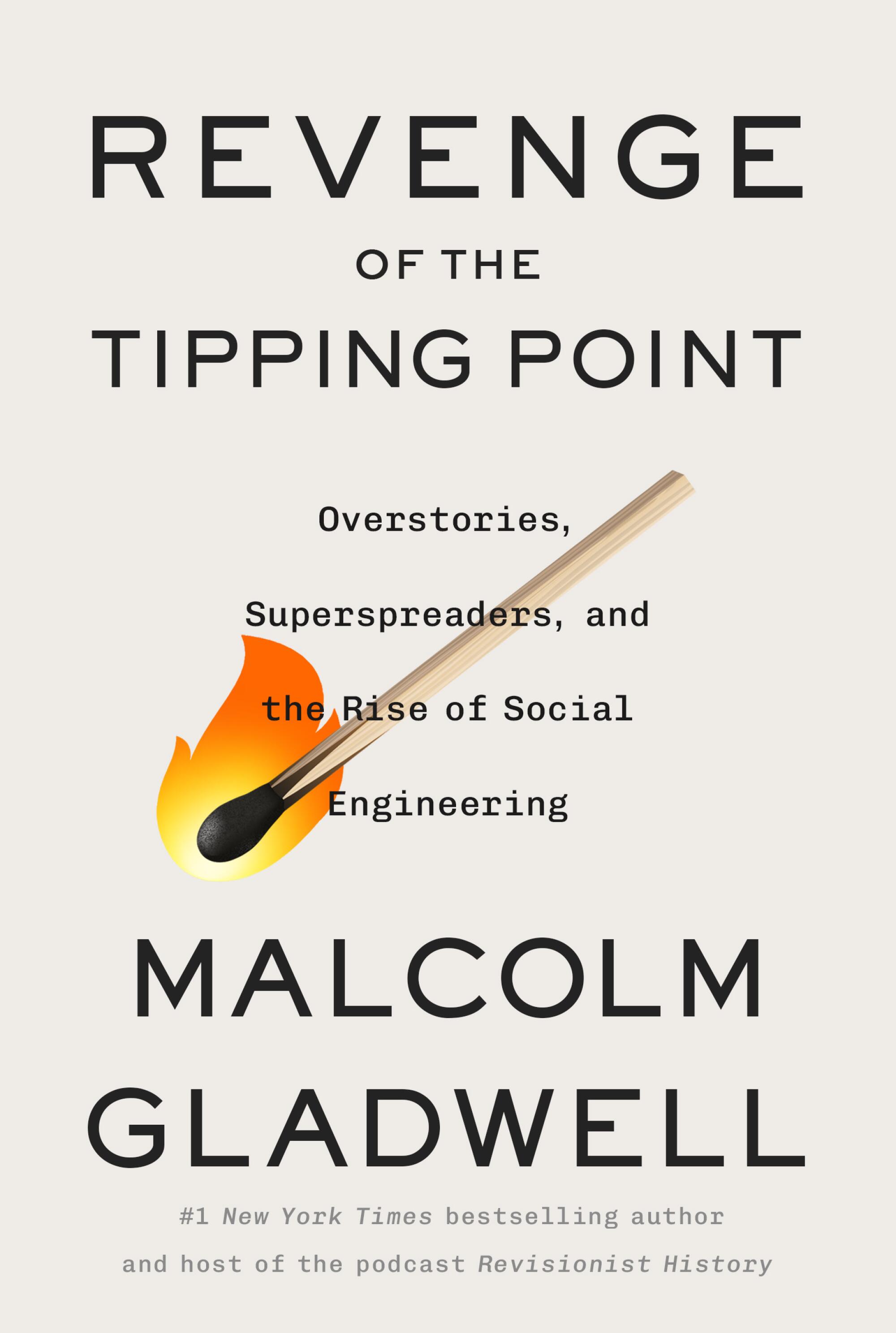
- Share via
Book Review
Revenge of the Tipping Point: Overstories, Superspreaders, and the Rise of Social Engineering
By Malcolm Gladwell
Little, Brown & Co., 368 pages, $32
If you buy books linked on our site, The Times may earn a commission from Bookshop.org, whose fees support independent bookstores.
It’s fair to say that “The Tipping Point” was the tipping point for Malcolm Gladwell’s career. In 2000, the book catapulted Gladwell, then a New Yorker staff writer, to literary superstardom. It also jump-started a new genre of explanatory social science books aimed at mass audiences.
The concept of the tipping point — the moment when everything suddenly changes, and a phenomenon becomes an epidemic — was not original to Gladwell. But he enshrined it in our cultural parlance. “By the time the paperback came out,” he writes in his sequel, “Revenge of the Tipping Point,” “it was part of the zeitgeist.” Over the years, Gladwell, now also a podcast entrepreneur, has churned out more bestsellers, among them “Blink” (2005), “The Outliers” (2008) and “Talking to Strangers” (2019). To his adept synthesis of academic research he adds journalistic curiosity, a crisp prose style and a mastery of counter-intuitive juxtapositions. Often beginning with a conundrum, he seeks out case studies and concepts that illuminate it, altering (slightly or radically) our understanding of the world.
“Revenge of the Tipping Point” follows that familiar formula. It remains tempting to dispute Gladwell’s repeated analogies between disease epidemics and social ones, and possible to wonder whether he is cherry-picking examples to serve his theories. At times, too, the narrative seems unduly slow and discursive, as he shifts, sometimes abruptly, from topic to topic. Still, Gladwell’s update of his ideas about tipping points will probably satisfy hard-core fans, and challenge and divert other readers.

The original “Tipping Point” concentrated on three main concepts that Gladwell argued were essential to understanding social epidemics. It described the Law of the Few, the indispensable role of messengers he called Connectors, Mavens and Salesmen; the Stickiness Factor, involving the durability of messages; and the Power of Context, meaning the broader landscape against which epidemics unfolded.
With “Revenge of the Tipping Point,” he offers “a new set of theories, stories, and arguments about the strange pathways that ideas and behavior follow through our world.” The title refers to the notion that the tools used to harness social epidemics for good also can have deleterious effects.
Bloomberg’s Parmy Olson delivers a buzzy, timely biography of AI’s promoters, but what are they promoting?
The book kicks off with an anonymized case study that many readers will immediately recognize: It involves a congressional hearing involving a company charged with fomenting an epidemic, and company witnesses loath to accept any blame.
Gladwell then introduces puzzles tied to case studies. He begins with an epidemic of bank robberies that swept Los Angeles but not the country, an example of “small-area variation.” Such variation, he argues, is a product of what he calls a community’s overstory, a set of cultural and social determinants. To the informed Gladwell reader, this seems like another take on the power of context.
Drilling down, Gladwell visits a much-studied community obsessed with high achievement, known in the social-science literature as Poplar Grove. In a classic Gladwell tic, he interweaves a seemingly unrelated story, about the genetic uniformity and vulnerability of cheetahs. He argues that these two populations — the town and the cheetahs — are both monocultures, and therefore lack resilience. That lack, along with a high-pressure environment, helps account for Poplar Grove’s suicide epidemic, he suggests.
Two historians, one living and one dead, believe we misunderstand the forces that drove the most famous slave rebel in American history.
The book’s next section deals with social engineering and the rule of the “magic third,” epitomized by white flight from city neighborhoods. Tipping points, Gladwell writes, “can be deliberately engineered.” One example, in Palo Alto: the Lawrence Tract, a planned community where white, Black and Asian people committed to living together in equal numbers in an attempt to avoid a racial tipping point, whatever the individual costs.
Another case study, highly relevant after the U.S. Supreme Court decision last year striking down race-based affirmative action in college admissions, involves the existence of a women’s rugby team at Harvard. Why does Harvard (a defendant in the affirmative action suit) need such a team, Gladwell asks, and, more broadly, why are so many academically mediocre athletes accepted to the university?
In skewering Harvard’s longtime dean of admissions, William Fitzsimmons, Gladwell is at his snarky best. One Fitzsimmons claim is that “having a vibrant athletic tradition … makes a big difference in our ability to attract all kinds of students.” But Harvard currently admits only a tiny 3.4% of its applicants, Gladwell notes, and “who is this imaginary person … who would turn down an offer from Harvard because the sports scene wasn’t sufficiently ‘vibrant’? ”
Rachel Kousser’s “Alexander at the End of the World” busts myths about the Macedonian king’s last years and his campaign into Asia while illuminating his multiculturalism.
In fact, Gladwell argues convincingly, Harvard uses sports to maintain its proportion of overwhelmingly white students “prepared … on the country-club playing fields of the United States.” It is not entirely clear from his analysis whether the whiteness or the wealth of those students is the determining factor in Harvard’s calculations, nor exactly how this predilection interacts with Harvard’s efforts to diversify its student population. But, in Gladwell’s view, “The wrong affirmative action was brought before the court.”
Gladwell also discusses at length the notion of the super-spreader event, familiar from the COVID-19 pandemic and epitomized by the February 2020 meeting of the biotechnology firm Biogen in Boston. Here we get a long disquisition on aerosol transmission, saliva and dehydration — and, in the end, what seems like a variation on the old idea of the lopsidedly powerful messenger.
Then we move to what Gladwell calls zeitgeist overstories, a way of conceptualizing cultural change. He cites the role of the 1978 television miniseries “Holocaust” in transforming the politics of memory, and of the comedy “Will & Grace,” which first aired in 1998, in revolutionizing ideas about gay people and relationships. “Overstories,” Gladwell writes, “are far more volatile than they may appear.”
In the final payoff, Gladwell cleverly applies these concepts to his demystified case study, which seems to straddle the divide between social and biological epidemics.
It is not necessary to buy everything Gladwell is selling to appreciate “Revenge of the Tipping Point.” It turns out that trying to poke holes in his arguments is at least half the fun.
Julia M. Klein is a cultural reporter and critic in Philadelphia.
More to Read
A cure for the common opinion
Get thought-provoking perspectives with our weekly newsletter.
You may occasionally receive promotional content from the Los Angeles Times.













